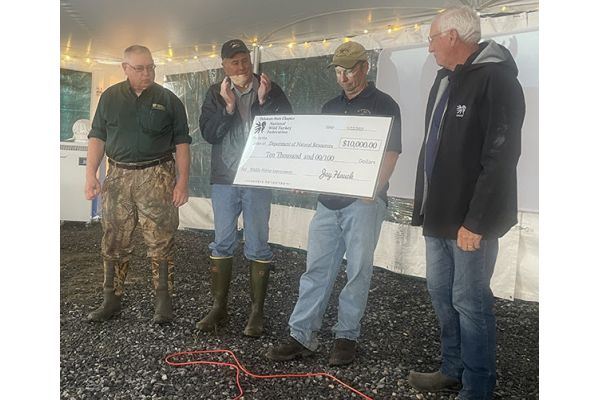EDGEFIELD, S.C. — The Delaware NWTF State Chapter recently donated $10,000 to the Delaware Department of Natural Resources and Environmental Control (DNREC) Division of Fish and Wildlife to continue a long-term habitat management and restoration project for wild turkeys, northern bobwhite quail and other wildlife species. The donation was presented during the second annual early successional habitat and restoration workshop at Cedar Swamp Wildlife Area.
“We’ve been partnering with the DNREC for about 40 years now,” said Charles Spray, Delaware NWTF State Chapter president. “We worked with them to re-establish wild turkeys 45 years ago. Before that, we had no wild turkeys, and thanks to our collaboration, we now have a healthy population. In fact, almost every season, including that which just ended in May, produces a record harvest of turkeys for the state as the flock keeps growing.We hope to continue working with them and maintaining our very strong partnership with them throughout the years.”
The Delaware NWTF State Chapter contribution helped the DNREC purchase a 75-gallon fire suppression skid unit. Four years ago, the state chapter also donated $10,000 to help get this project off the ground, and it has grown significantly. Now, the work is extending the project into the southern portion of the state.
“Cedar Swamp Wildlife Area is 6,000 acres, and we approach habitat management with a total ecosystem approach, focused on benefiting as many species as possible,” said Eric Ludwig, Division of Fish and Wildlife program manager. “Northern bobwhite quail and Eastern wild turkeys have been two species that have greatly benefited from the habitat management in the area.”
This project started with the intent of eliminating the invasive autumn olive and planting native shrubs to maintain the existing quail population. As a result, there was also an increase in rabbit populations and songbirds. This year, the team has already detected quail on two properties in Kent County, which haven’t seen quail since 1999.
Ludwig and his team have used prescribed fire on the area every year, burning up to half of the upland fields each year. After burning the fields, plows are used to eliminate any remaining woody plants that are encroaching into the fields. These burns are important to maintain early successional habitat, which is essential for turkeys and quail. Most of the fields have been planted with native seed to combat invasive species, which is important for producing insects for both quail and turkey.
“The NWTF and the DNREC Division of Fish and Wildlife have had a working relationship for at least the last 15 years,” said Ludwig. “As most people know, what is good for quail habitat it is also good for turkey habitat. The donation from the Delaware Chapter of the National Wild Turkey Federation has allowed this project to be a major success. The NWTF has been a partner since the beginning of this project and has been one of the few organizations that has seen the need for maintenance on the establishment of these new fields.”
About the National Wild Turkey Federation
Since 1973, the National Wild Turkey Federation has invested over half a billion dollars into wildlife conservation and has positively impacted over 24 million acres of critical wildlife habitat. The NWTF has also invested over $10 million into wild turkey research to guide the management of the wild turkey population and to ensure sustainable populations into perpetuity. The organization continues to deliver its mission by working across boundaries on a landscape scale through its Four Shared Values: clean and abundant water, healthy forests and wildlife habitat, resilient communities, and robust recreational opportunities. With the help of its dedicated members, partners and staff, the NWTF continues its work to provide Healthy Habitats. and Healthy Harvests. for future generations.
Read the full article here




